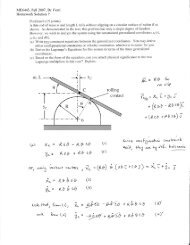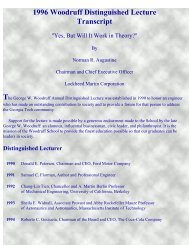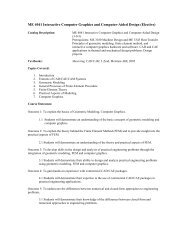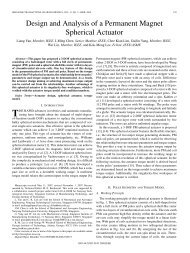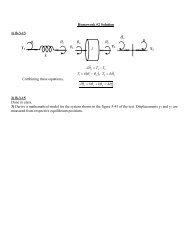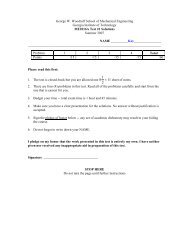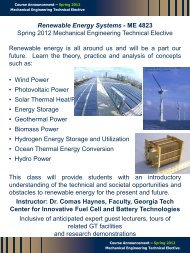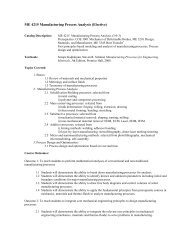ME 4321 Refrigeration and Air Conditioning (Elective)
ME 4321 Refrigeration and Air Conditioning (Elective)
ME 4321 Refrigeration and Air Conditioning (Elective)
- No tags were found...
Create successful ePaper yourself
Turn your PDF publications into a flip-book with our unique Google optimized e-Paper software.
<strong>ME</strong> <strong>4321</strong> <strong>Refrigeration</strong> <strong>and</strong> <strong>Air</strong> <strong>Conditioning</strong> (<strong>Elective</strong>)Catalog Description: <strong>ME</strong> <strong>4321</strong> <strong>Refrigeration</strong> <strong>and</strong> <strong>Air</strong> <strong>Conditioning</strong> (3-0-3)Prerequisites: <strong>ME</strong> 3322 Thermodynamics <strong>and</strong> <strong>ME</strong> 3345 HeatTransferApplication of thermodynamics, heat transfer, fluid mechanics, thermal comfortprinciples, <strong>and</strong> good practice to the analysis <strong>and</strong> design of air-conditioning,heating, <strong>and</strong> refrigeration systems; including consideration of vaporcompression <strong>and</strong> heat-driven refrigeration, air-vapor psychrometrics, loadestimates, air delivery <strong>and</strong> distribution, <strong>and</strong> building energy system controls.Textbook:Harry J. Sauer, Ronald H. Howell, <strong>and</strong> William J. Coad, Principles of Heating,Ventilating, <strong>and</strong> <strong>Air</strong> <strong>Conditioning</strong>, ASHRAE, Current Ed.Topics Covered:1. Overview of HVAC <strong>and</strong> methods for controlling the indoor environment2. Basic <strong>and</strong> applied psychrometrics3. Thermal comfort conditions <strong>and</strong> ASHRAE Std 554. Outdoor air ventilation requirements <strong>and</strong> ASHRAE Std 625. Overview of system alternatives <strong>and</strong> system design <strong>and</strong> selection6. Overview of HVAC design conditions <strong>and</strong> loads7. Heat transfer in building walls, panels, <strong>and</strong> fenestration8. Solar radiation principles, solar geometry, Solar Heat Gain, Sol-air temperature9. Details of load calculations by CLTD/CLF/SCL for zones <strong>and</strong> building10. Overview of the RTS method <strong>and</strong> building simulations11. Heating load calculations12. Supply air calculations for zones <strong>and</strong> building13. Overall flow rates <strong>and</strong> refrigeration loads (at the AHU)14. Cooling <strong>and</strong> dehumidification processes15. Cooling <strong>and</strong> dehumidification systems, refrigerant selection16. Fluid flow distribution: duct <strong>and</strong> piping system design17. Room air distribution <strong>and</strong> the ADPI including CFD analysis when feasible18. Estimating energy consumption19. Evaluating energy conservation opportunities <strong>and</strong> ASHRAE Std 9020. Advanced, innovative, or alternative system designs, comparison with contemporary designsCourse Outcomes:Outcome 1: Introduce students to HVAC technology, engineering, research, systems, system designs,energy impacts, <strong>and</strong> overall goals1.1 Students will demonstrate an underst<strong>and</strong>ing of the need <strong>and</strong> importance of HVAC technology,the typical <strong>and</strong> some advanced <strong>and</strong> innovative schematic designs, <strong>and</strong> the goals of HVACengineering <strong>and</strong> HVAC systemsOutcome 2: Develop underst<strong>and</strong>ing of the principles <strong>and</strong> practice of thermal comfort2.1 Students will demonstrate an underst<strong>and</strong>ing thermal comfort conditions with respect totemperature <strong>and</strong> humidity <strong>and</strong> human clothing <strong>and</strong> activities <strong>and</strong> its impact on human comfort,productivity, <strong>and</strong> healthOutcome 3: Develop underst<strong>and</strong>ing of the principles <strong>and</strong> practice <strong>and</strong> requirements of ventilation3.1 Students will demonstrate an underst<strong>and</strong>ing the needs <strong>and</strong> requirements for ventilation <strong>and</strong> itsimpact on design <strong>and</strong> energy <strong>and</strong> its impact on human comfort, productivity, <strong>and</strong> health
Outcome 4: Develop generalized psychrometrics of moist air <strong>and</strong> apply to HVAC processes4.1 Students will demonstrate an underst<strong>and</strong>ing of psychrometrics <strong>and</strong> its application in HVACengineering <strong>and</strong> design <strong>and</strong> will practice or observe psychrometric measurementsOutcome 5: Review heat transfer <strong>and</strong> solar energy engineering <strong>and</strong> develop techniques for the analysis ofbuilding envelope loads5.1 Students will demonstrate an underst<strong>and</strong>ing of heat transfer in buildings with a givenarchitectural design <strong>and</strong> its application to heating <strong>and</strong> cooling load estimation especially includingthermal lag effects by conducting a detailed annual load analysis for a representative building <strong>and</strong>present the results of this analysis in a formal report possibly including recommendations forenergy conservationOutcome 6: Review thermodynamics <strong>and</strong> thermal systems engineering <strong>and</strong> develop underst<strong>and</strong>ing of vaporcompression <strong>and</strong> possibly heat-driven refrigeration systems <strong>and</strong> evaporative cooling systems6.1 Students will demonstrate an underst<strong>and</strong>ing of the engineering <strong>and</strong> operation of vaporcompression <strong>and</strong> possibly heat-driven refrigeration systems <strong>and</strong> evaporative cooling systems <strong>and</strong>underst<strong>and</strong> contemporary issues of ozone depletion <strong>and</strong> global warming potential with respect torefrigeration systemsOutcome 7: Review fluid mechanics <strong>and</strong> engineering <strong>and</strong> develop techniques for the analysis of duct <strong>and</strong>piping systems <strong>and</strong> room air distribution systems <strong>and</strong> review associated turbomachines <strong>and</strong> control systems7.1 Students will demonstrate an underst<strong>and</strong>ing of fluid mechanics in building air or coolantdistribution systems <strong>and</strong> in room air distribution <strong>and</strong> its application to efficient piping <strong>and</strong> ductsystems <strong>and</strong> effective room air distribution systems <strong>and</strong> associated flow machines <strong>and</strong> controlsystemsOutcome 8: Present overview of methods to predict seasonal <strong>and</strong> annual energy consumption <strong>and</strong> overviewdesign guidelines <strong>and</strong> st<strong>and</strong>ards for energy efficient buildings <strong>and</strong> building energy systems8.1 Students will demonstrate a working underst<strong>and</strong>ing energy prediction methods <strong>and</strong> energyrelated codes <strong>and</strong> st<strong>and</strong>ards underst<strong>and</strong> contemporary issues energy conservation <strong>and</strong> globalwarming potential with respect to HVAC systemsCorrelation between Course Outcomes <strong>and</strong> Program Educational Outcomes:<strong>ME</strong> <strong>4321</strong>Mechanical Engineering Program Educational OutcomesCourse Outcomes a b c d e f g h i j k lCourse Outcome 1.1 X X X XCourse Outcome 2.1 X X X X XCourse Outcome 3.1 X X X X X XCourse Outcome 4.1 X X XCourse Outcome 5.1 X X X X X X X X X X XCourse Outcome 6.1 X X X X X XCourse Outcome 7.1 X X X X X X XCourse Outcome 8.1 X X X X X X X X XPrepared by: Sheldon Jeter



